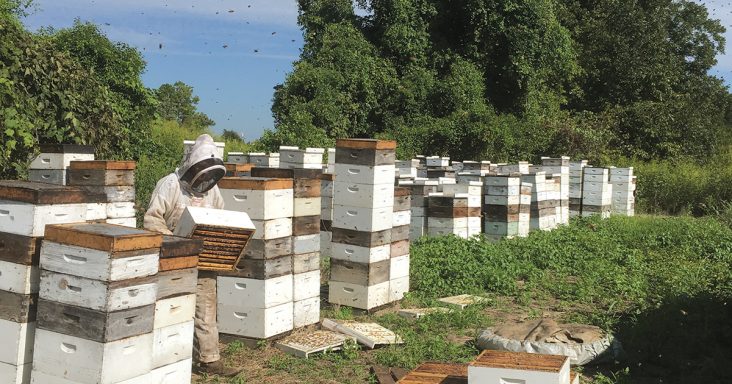Key to profitable honey farm work is finding the ‘right balance’ with bees
by October 15, 2018 6:45 pm 4,972 views

Bee hives at Coy's Honey Farm in Craighead County.
Harvest is always a special time in Arkansas and across the Mid-South, with the gathering of crops signifying the conclusion of the growing season.
But for Craighead County brothers and business partners Richard and David Coy, the buzz surrounding their headquarters building just north of Jonesboro near Brookland signifies not that their work for the season is over, but it is time to move into the next phase of their operation.
The Coys, who are vice presidents of Coy’s Honey Farm, the operation founded in 1969 by their father, Bobby, are at work gathering the crop of approximately 1 million pounds of honey produced by their thousands of hives around the Delta. The company, considered the largest commercial honey operation in Arkansas, employs about 15 people, with a few more added seasonally as needed. The Coys belong to the Sioux Honey Cooperative and sell their honey to the cooperative.
Bees are essential to the world’s food supply. Approximately one-third of the human diet comes from insect-pollinated plants, and the honeybee is responsible for 80% of that pollination.
Bees from Coy’s Honey Farms pollinate watermelons, cucumbers and squash in Arkansas. Row crops such as soybeans are wind-pollinated and don’t require bees for pollination. But bees can enhance their productivity, Richard said, and soybean yields can increase 5% to 10% when bees are present.
“We pick the farmers we want to put bees on because of their farming practices,” David said.
In past years, Richard said, “We went from Brookland an hour” to place hives near farms to help pollinate crops and produce honey. “Now we go 2.5 hours [south] to get the acres we need.”
“When I was a kid,” Richard said, “Mississippi County was the county with the highest production in the state. But we travel to the Cache River now. It costs more money and takes more labor.”
And for the Coys, the rewards are not as sweet as in past years.
“As honey production continues to decline below the cost of production, we have begun selling bees to make up the lost revenue,” Richard said. Simply put, “production is not as good and it’s farther away.”
In late September, the Coys began sending the first of five or six truckloads of beehives to the Mississippi Gulf Coast to spend the winter. In late January and early February, the Coys will send about 4,000 hives of 20,000 bees each to California to help pollinate the almond crop.
“Almond pollination is keeping the U.S. beekeeper in business,” Richard said.
After the almond trees finish flowering in mid-March, a broker gathers Coy’s bees and trucks them home. About 2,500 of those hives are sent to Coy’s operation in Gulfport, Miss., where they can begin making honey earlier than in Arkansas. In May, when plants in the Delta are flowering, he puts hives on farms along a wide area from the Arkansas-Missouri state line to near Marianna.
The Gulf Coast honey season ends in mid-summer, so the hives are moved to Arkansas and Mississippi. For the past several years, half of the honey the operation produced came from the state of Mississippi. However, this year “we’ve made 600,000 pounds out of Mississippi, or 60% of our production,” Richard said.
The Coys have about 1,600 hives in the Tutwiler-Webb-Sumner area of Mississippi. In Mississippi, bees forage on the Chinese Tallow tree, a non-native species that government agencies in some states want to destroy by importing a non-native beetle to act as a biological control agent.
If the effort to eliminate bees’ Mississippi forage source didn’t sting enough, beekeepers and bees face a number of challenges to their survival, Richard said. Parasites — in particular the varroa mite — disease, poor nutrition and lack of genetic diversity are among challenges.
David, who joined the family business full time after earning an agriculture degree at Arkansas State University, raises the farm’s breeding stock. The Coys use Russian honeybees because of their resistance to mites. By a process called grafting, day-old bee larvae are transferred into special queen cups the same size as natural queen cells in order to produce multiple queens, David said.
Richard said he started noticing in 2016 that their honey production was reduced in areas where the herbicide dicamba was being used. What happened, he said, was pollen stopped coming into the hives in areas where dicamba drift could affect the non-target (non-crop) plants that bees visit for pollen. Pollen, he said, is the source of protein for bees, and nectar is the carbohydrate source.
David said for the foreseeable future, the company will have to rely on less honey production and more sales of bees, a strategy he called “a formula for going out of business.”
“We’ve got to find the right balance,” Richard said.
